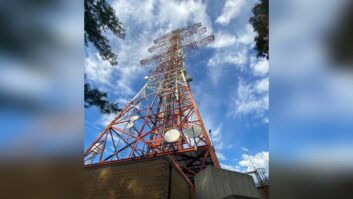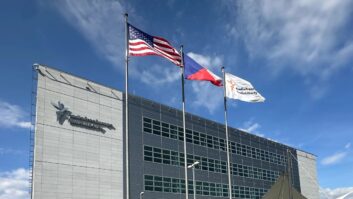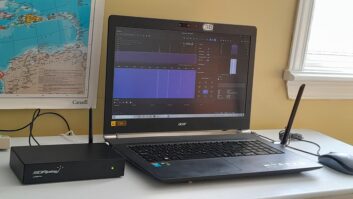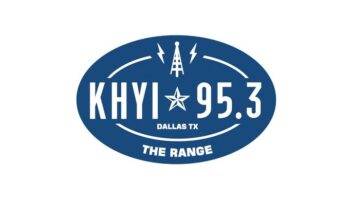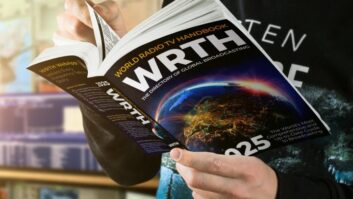
Saying it has received strong public support, the grassroots crowdfunding campaign Shortwaves for Freedom this week announced additional shortwave radio broadcasts to Russia, Belarus, Ukraine and other parts of Eastern Europe.
The broadcasts consist of rebroadcast content from Voice of America (VOA) and Radio Free Europe/Radio Liberty (RFE/RL). The content is in the public domain and available for unauthorized reuse, the campaign said.
“We quickly raised enough money from our online appeal to start funding transmissions last Tuesday to the region from a private FCC-licensed shortwave station in Florida and from early this week we are expanding broadcasts from commercial stations outside the United States,” said Kate Neiswender, a California lawyer and spokesperson for the campaign.
The private U.S. shortwave station that Neiswinder referred to is WRMI Radio Miami International in Okeechobee, Fla., which is owned and operated by longtime shortwave enthusiast Jeff White.
According to Shortwaves for Freedom, reception of the initial WRMI broadcast have been confirmed in the targeted countries. They are being sent via the station’s 100,000-watt transmitters beaming to Eastern Europe.
“We sell airtime for $60 per hour,” said White. “The reach is very good at certain hours into Eastern Europe on the two frequencies we currently use: 7780 and 15770 kHz.”
As strong as WRMI’s signals are, the additional non-U.S. shortwave transmitters “will put a stronger shortwave signal into the target region and add medium-wave,” said Gerhard Straub. He is former director of USAGM’s Broadcast Technologies Division and one of the experts advising Shortwaves for Freedom on their broadcast options.
Shortwaves for Freedom said it has raised more than $18,000 from individual donors through its FundRazr campaign, which is 180% over its initial $10,000 goal.
The money is being used to purchase airtime on commercial shortwave stations, whose targeted broadcasts can reach large areas from great distances, such as Eastern Europe from Florida. In addition to Russian and English language programs from VOA and RFE/RL, the group plans to fund Ukrainian language programs to reach Ukrainians.
Shortwaves for Freedom’s VOA and RFE/RL broadcasts are not backed by the United States Agency for Global Media, the parent group of those media outlets.
Nor is the VOA planning to add shortwave broadcasts to this region.
“Our research indicates there are few shortwave sets in use in that part of the world, so it’s not in our current plan to add SW broadcasts,” said Bridget Ann Serchak, the VOA’s director of public relations. “However, we have begun a satellite TV station to provide additional content for eastern Europe and are exploring other methods of transmission.”
This argument doesn’t sit well with Straub, who is knowledgeable about the VOA’s broadcast capabilities and its target audiences.
“In times of crisis if the content is compelling, the audience will go where they know the information is,” he said.
Given that the Putin regime has cut off Russia’s access to western online news media, it seems likely that some Russians who still have old receivers are bound to dust them off, tune in and share that information with others, as they did during the height of the Cold War. Meanwhile, the addition of medium-wave will allow people with conventional AM/FM radios to hear the broadcasts.
“We hope USAGM will realize the dire need for radio broadcasts at a time of war when millions of people have been cut off from the internet and credible TV news due to censorship by Russia, the destruction of infrastructure and their homes,” said Neiswender. “Until the U.S. government decides to adequately return to radio — both shortwave and medium-wave or “AM radio” — we will fund transmissions as long as we have money.”
Here is the current schedule for Shortwaves for Freedom’s SW broadcasts to Eastern Europe; the times are in UTC, a 24-hour clock four hours ahead of EDT:
02:00-04:00 UTC Radio Svoboda (RFE/RL Russian): 7780 kHz (SW)
18:00-19:00 UTC Radio Svoboda: 1395 kHz (MW)
19:00-20:00 UTC Radio Svoboda: 9370 kHz (SW)
19:30-20:00 UTC ‘Flashpoint Ukraine’ (VOA English): 15770 kHz (SW, Monday-Friday)
Shortwaves for Freedom says it is not affiliated with any government, political, corporation organization or special-interest group and that all funds received go to pay for broadcast transmissions.
